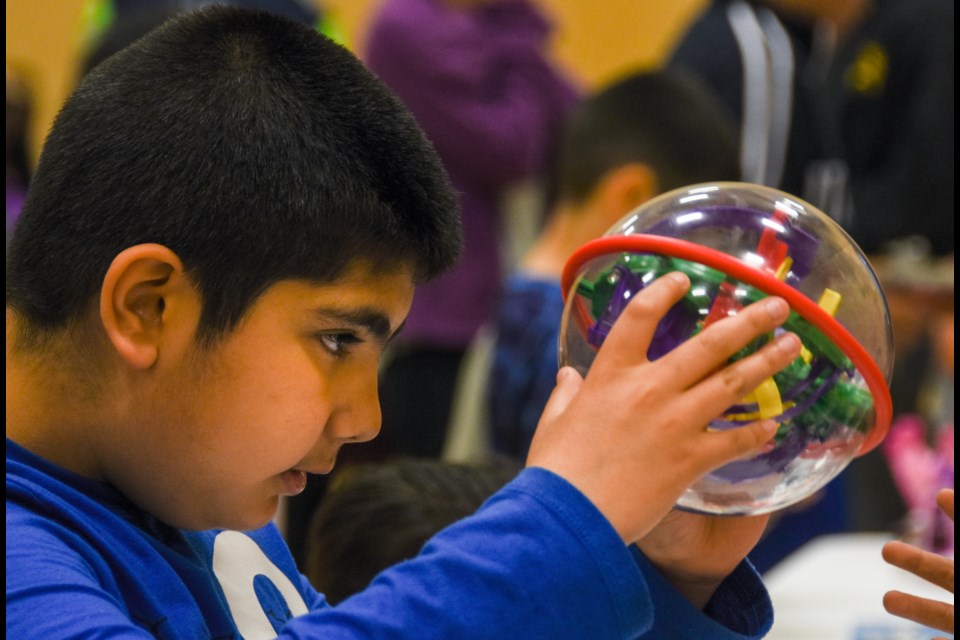Students at James Park Elementary School sold off their toys this Friday, May 24, in an effort to help build schools on the other side of the planet.
By late morning, hundreds of children lined up to fill the school’s gymnasium, wave after wave peering through the glass doors to get a look.
Inside, teachers, students and supervising parents had laid out tables in a broken ring around the gym, each one bearing carefully displayed toys, a dollar a piece, to entice their fellow students.
There were board games, from Funky Monkeys (“Be the top banana”) to Where in the World is Carmen San Diego, Junior Edition; toys, from t-rex rubber gloves for tiny arms to an X-wing fighter; and pile after pile of books.
“I got silly string! I got silly string!” shouted one kid intoxicated with a garage sale discovery as he did a victory lap around the gym.
Billed as a Toy Garage Sale, the event was the culmination of months of learning, in which students reflected on their lot in the world.
Angelia Mouland, whose idea sparked the project, was first inspired last summer, when she was stuck looking for a book. That's when she came across Three Cups of Tea, the widely popular book that traces the unsuccessful attempt by author Greg Mortenson to scale a mountain in Pakistan only to be turned back and nursed to health by the people of a mountain village when he loses his way. When the author realizes the village doesn’t have a school, he vows to return and build one.
At one point, the book and non-profit Mortenson set up to build the schools had gained such popularity that it sparked a movement to build schools across remote villages in countries like Pakistan and Afghanistan where many girls don’t have access to school — even Barak Obama donated $100,000 of his Nobel Peace Prize winnings to the charity.
“Oh my God, I need to be a part of this,” thought Mouland after finishing the book.
But when she went to the link at the end of the book, things started to unravel.
If the story seemed too good to be true, it’s because it was. Renowned journalist and climber Jon Krakauer was initially just as captivated as Mouland and reportedly donated several thousand dollars of his own money to the charity. But when cracks started to appear in the story, Krakauer found Mortenson had bent the timeline and several facts to serve his own goals.
Mortenson’s reputation plummeted, but his foundation endured, renamed Pennies for Peace.
“He may have screwed up,” said Mouland. “[But] I decided to still go ahead with it. Sometimes people with good intentions don’t always get it right in the beginning.”
Of course, her young students weren’t going to read the novel, and short of going to the Hindu Kush mountains, she grappled with how to get a seven-year-old to understand what’s at stake for kids on the other side of poverty, on the other side of the world.
After teaching for 32 years, Mouland decided to toss the overly complex Pennies for Peace education pack and sketched out her own plan. When she presented it to several other teachers, they decided to join her.
Much of what came next came from Mouland's philosophy trusting students to discover big ideas and how they relate to the world, especially when it comes to education.
“This is their life. This is their job, going to school. They know it quite well,” she said.
So over several months Mouland helped guide her students to reflect on what they had, one thing at a time. Every day the students would write about something they were grateful for on a sticky note. Their ideas would make their way to a sprawling web on the board: calendars, backpacks and pencils; doors, swings and a roof; teachers.
Then Mouland would erase them one at a time as they learned what students in the poor, high-altitude villages of central and South Asia didn’t have. By the end of the exercise they were left with “boy” and “girl.”
“Through all of this we were practicing gratitude, deep breathing, we would take in about 10 deep breaths,” said Mouland.
The students went from “If I didn’t have to go to school, I would play all day,” to “I wonder why you have to boil water first in India to drink it and not here in Canada?”
Once she gave an opportunity for the students to understand the deprivations of other children far away, she offered them the chance to make a change.
“A lot of young people feel anxiety about all the negative things in the world they hear about, that they’re lost, that they’re a cog in the wheels,” said Mouland.
“It empowers them. They feel that they’re doing something positive for someone else. What a great way for them to feel that they can be a change in the world.”
Back at the gymnasium, students darted from table to table, first selling off their toys then seeing what they could pick up for a dollar. In the end, the students would raise nearly $400.
But for seven-year-old Soham Sharma, the calculation was simple.
“Not everybody can get an education. Most often, it’s only the boys that get an education. So we can help,” said Sharma.
“It’s important that girls get one too.”
It’s that kind of empathy that has Mouland already thinking ahead.
“Maybe next year we find a new cause,” she said, half talking to herself with a smile.



